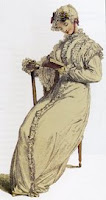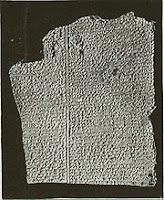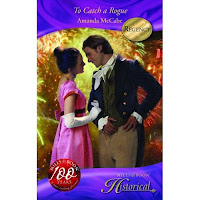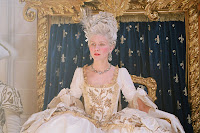
Hello everyone! First of all, I know everyone joins me in sending our love to Elena and her family, along with best wishes for her husband’s speedy recovery. I’ve big shoes to fill, but I’m honored the Riskies have invited me to guest blog today. It’s always such fun to be part of the lively exchange of ideas here!
Recently, I’ve been thinking a lot about not just the written word but the spoken word. I wasn’t one of those kids who went out for school plays, so when my editor at Grand Central Publishing asked me to do a podcast on why I love the Regency era, I was more than a little nervous. And then, on top of that, I was asked to be part of a romance reading in New York City next week. Gulp. Speak aloud? Read from my books? The sweat was already trickling down my spine.
 Writing the podcast was easy–then I started to practice saying it aloud. The first attempt came out as a croak. The second herky-jerky stumbling. Finally, I was able to get through it without too many hitches. But now, that reading awaits, and I’ve started another round of practice. For those who haven’t tried it, reading aloud isn’t easy! Oh, mumbling the words doesn’t take much effort, but to capture the mood and nuances of the story, to make the characters come alive, is a daunting challenge. It made me realize how, with CDs, DVDs, TV, I-pods, and the Internet to keep ourselves amused, reading aloud is pretty much a lost art.
Writing the podcast was easy–then I started to practice saying it aloud. The first attempt came out as a croak. The second herky-jerky stumbling. Finally, I was able to get through it without too many hitches. But now, that reading awaits, and I’ve started another round of practice. For those who haven’t tried it, reading aloud isn’t easy! Oh, mumbling the words doesn’t take much effort, but to capture the mood and nuances of the story, to make the characters come alive, is a daunting challenge. It made me realize how, with CDs, DVDs, TV, I-pods, and the Internet to keep ourselves amused, reading aloud is pretty much a lost art.
Of course, that wasn’t so in the Regency. Just look at the novels of Jane Austen to see countless examples of how the practice was woven into the fabric of everyday life. Fanny Price, like so many poor relations and paid companions, was expected to keep her aunt’s boredom at bay by reading to her. The Bennet sisters had to sit through Mr. Collins’s pompous readings of religious texts.
We’re also constantly reminded of how one of the main sources of evening entertainment for a family was reading a novel together after dinner, with each family member taking a turn. Poetry was also popular–though I imagine not many parents allowed their daughters to recite Byron’s Don Juan aloud!
 The more I thought about it, the more I realized the oral tradition of storytelling has been part of the human experience since the dawn of civilization. Starting with the ancient Mesopotamian Epic of Gilgamesh, which dates from around 2000 BC, where we see the archetypal theme of “hero and quest”–ha, you see, romance was at the root of our imagination even then! This continues with Beowulf and epic Greek poems like The Illiad and The Odyssey.
The more I thought about it, the more I realized the oral tradition of storytelling has been part of the human experience since the dawn of civilization. Starting with the ancient Mesopotamian Epic of Gilgamesh, which dates from around 2000 BC, where we see the archetypal theme of “hero and quest”–ha, you see, romance was at the root of our imagination even then! This continues with Beowulf and epic Greek poems like The Illiad and The Odyssey.
 The Middle Ages saw the rise of the troubadour tradition, which combined epic poetry and song. The French courts developed the idea of Courtly Love, and Eleanor of Aquitaine brought this tradition to England when she married Henry II. During this time we also see the rise of the Arthurian legends. Love, honor, jealousy, sex, betrayal–the romance is heating up!
The Middle Ages saw the rise of the troubadour tradition, which combined epic poetry and song. The French courts developed the idea of Courtly Love, and Eleanor of Aquitaine brought this tradition to England when she married Henry II. During this time we also see the rise of the Arthurian legends. Love, honor, jealousy, sex, betrayal–the romance is heating up!
Dante, Milton…I could go on and on, but fast-forward to today, where the idea of going and listenting to someone reading aloud seems something of an oddity, a quaint, old-fashioned throwback to the past. I suppose that audio books are the closest thing we have to the oral tradition.
 But back to my own experience. After practicing until I’m blue in the face, I have come to two realizations. One–I made a wise career choice in steering away from the performing arts. Two–much as I want to like listenting to stories, I still prefer to read them. I’m one of those people who just doesn’t follow a narrative well by listening. It seems to go in one ear and out the other. My mind wanders–I forget what I heard–a particular voice isn’t my idea of the character. I need to see the words on the page (yes, I still prefer books to e-readers!) to go at my own pace, to hear my own voices for the characters.
But back to my own experience. After practicing until I’m blue in the face, I have come to two realizations. One–I made a wise career choice in steering away from the performing arts. Two–much as I want to like listenting to stories, I still prefer to read them. I’m one of those people who just doesn’t follow a narrative well by listening. It seems to go in one ear and out the other. My mind wanders–I forget what I heard–a particular voice isn’t my idea of the character. I need to see the words on the page (yes, I still prefer books to e-readers!) to go at my own pace, to hear my own voices for the characters.
What about you? Do you enjoy both? Can you absorb both?
What are some favorite stories for hearing aloud?
Andrea will be reading, along with Hope Tarr, at 7:00 pm on February 2, at Madame X, 94 West Houston Street! More details here
























